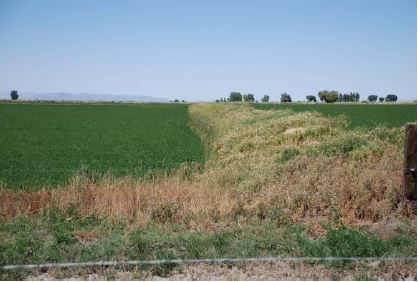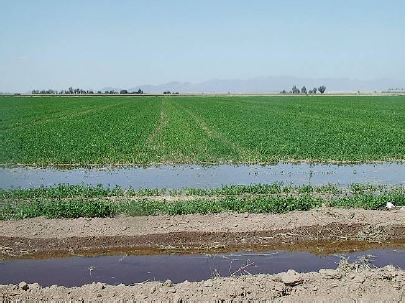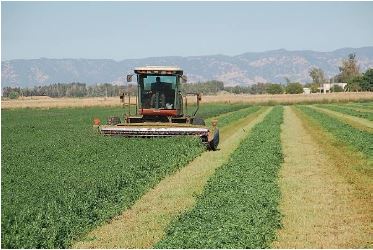Seedling alfalfa is vulnerable to weed competition because seedlings grow slowly and do not compete well with weeds. Weed competition in new alfalfa stands impedes root development and lowers forage quality and alfalfa yield. The damage caused to seedling alfalfa can last the life of the stand. As such, weeds are often the most significant pests of new alfalfa stands.
Integrated Weed Management (IWM) involves the use of all available weed control options, such as planting improved or appropriate varieties, fertilization, crop rotation, tillage practices, and mechanical, biological, and chemical controls. No single weed control measure can be successful as a stand-alone practice due to the number of weed species and their highly variable life cycles and species survival strategies. In addition, if only one or two strategies are used, weeds will adapt to those practices. Applying the principles of IWM can minimize the overall economic impact of weeds, reduce herbicide use and provide optimum economic returns to the producers.
Field History
Effective weed management requires an understanding of weed biology and knowledge of the field history of weeds. Weeds can be annual, biennial or perennial. It is also important to know the life cycles because it will determine how each weed is best managed.
Annual weeds can be either summer or winter annuals. Winter annual weeds germinate in the fall through early spring (October to March). They grow rapidly in the spring and are usually a problem only in the first cutting. Summer annual weeds germinate as temperatures rise in late spring (April to May) through summer. Biennial weeds take up to two years to complete their life cycle. Vegetative growth occurs during the first year and seed production usually does not occur until the second year. Perennial weeds live more than two years. In addition to reproduction by seed, they can reproduce by vegetative structures such as rhizomes, stolons and tubers. Planting into clean fields free from perennials and other persistent weeds is the first step in a weed-management program. Such weeds are difficult to manage in a perennial crop.
Crop Rotation
Crop rotation can be effective for reducing weed populations in new alfalfa stands, as some weeds are more easily controlled in one crop than in another. Common crops used in rotation with alfalfa in Nevada include small grain hay, corn grown for silage and perennial grass hay. Annual crops, such as small grains and corn, compete more aggressively with perennial weeds, and also have more herbicide options for weed control. Broadleaved weeds are more difficult to control in a broadleaved crop such as alfalfa. A rotation away
from alfalfa for at least two years is recommended to
disrupt weed, disease and insect life cycles.

Seedbed Preparation
A well-prepared seedbed is important for maximizing crop emergence, which makes the crop more competitive against weeds. Light tillage can stimulate the germination of weed seeds and destroy sprouting seeds located near the soil surface. However, it also breaks the dormancy of additional weed seeds.
Proper land-leveling and laser-finishing promote the uniform distribution of irrigation water and improve drainage, which contributes to the management of weeds. Water collects in low spots in non-level fields, drowning alfalfa and leaving open spaces for weeds to invade.
Proper nutrient management aids weed management. Growers who apply recommended amounts of fertilizer prior to planting give their forage crops a competitive advantage. Conversely, over-applying fertilizer can harm the forage and give weeds an advantage. Soil sampling and analyses are recommended to determine the nutritional status of the soil prior to fertilizer application.
Some growers irrigate their fields prior to planting in order to germinate weed seeds present in the soil. Similarly, a “stale” seedbed can be created by tilling the soil early, also encouraging weed germination. Once the seeds have germinated, the weeds can be lightly tilled under or killed with a pre-plant herbicide such as glyphosate (Roundup) or paraquat (Gramoxone).

Variety and Seed Selection
Planting certified seed is integral to preventing weed introduction. However, even the best-quality seed can still contain a very low percentage of weed seeds. Selecting varieties with the appropriate insect, nematode and disease resistance will help maintain a dense, vigorous stand that can withstand weed invasion. It is important to use alfalfa seed that is inoculated with nitrogen-fixing Rhizobium bacteria when seeding a field with no recent history of alfalfa.
Planting Time
Alfalfa should be planted when weed populations are minmal and growing conditions are optimal. Low temperatures favor the growth of winter annual weeds over seedling alfalfa, and high temperatures favor the growth of summer annual weeds. For both spring and fall planting, timing is determined by the presence of adequate irrigation water, and temperatures that ensure good germination and successful stand establishment. The weed spectrum is different between spring and fall plantings as well as between early and late spring plantings.
Seeding early in the spring will often allow the crop to get ahead of weeds that begin germination later in the spring. However, cold soil temperatures may delay seedling emergence, and late frosts can damage young seedlings – both of which favor weed invasions. For this reason, growers should wait until the soil begins to dry out, and until temperatures are warm enough for successful germination. Spring planting begins mid-March in some areas of Nevada, and continues through May.
Fall planting allows alfalfa to out-compete summer annuals, but is limited to areas that have adequate irrigation water. In August and early September, prior to frosts, numerous summer annual weeds are present; however, most of them will be killed by cultivation. Growers who plant later in the fall will have more problems with winter annual weeds and risk frost damage to the young alfalfa seedlings. It is best to have all seeds planted by the end of September.
Seeding depth and rate
Seeding alfalfa at the appropriate depth and rate is critical for crop establishment, which is critical for weed management. Seeding rates vary depending on seedbed preparation and planting method. A seeding rate of 18 to 20 pounds per acre drilled, or 20 to 25 pounds broadcast planted, will usually result in a dense, competitive alfalfa stand.
Companion crop
Spring planted alfalfa can be seeded with a companion crop – also called a nurse crop – usually oats or beardless wheat varieties. The nurse crop establishes more quickly than the alfalfa, providing ground cover that reduces erosion and weed competition, and increasing first cutting yields. It can be harvested and provides increased income during alfalfa establishment. However, the companion crop competes with alfalfa seedlings for light, moisture and nutrients, and research has shown they can negatively impact the long-term production of an alfalfa stand. This is common when seeding rates of alfalfa are too low, or seeding rates of the companion crop are too high. It is important not to seed the nurse crop at more than 30 to 40 pounds of seed per acre.
Cutting Management
Plant maturity is the single most important factor affecting forage yield, quality and stand persistence. Quality decreases as plants mature but frequent, early cuttings damage young alfalfa plants. Therefore, it is best to cut seedling alfalfa for hay at 10 percent bloom. Alfalfa is generally cut a minimum of two times in the seedling year. Cutting alfalfa can also reduce competition and shading from certain annual weeds. It is important to avoid mowing too short, which causes the plants to be more stressed and thus more susceptible to diseases and insects. It is recommended that producers cut above the emerging crown shoots (less than 2 inches) and to cut early enough in the fall to allow the alfalfa to re-grow a minimum of 4 inches (6 inches is optimum) before the first hard frost.
Herbicides
Chemical controls are used in combination with cultural controls to manage weeds in alfalfa seedlings. The repeated use of an herbicide, or of herbicides with the same mode of action, allows the few naturally occurring plants with resistance to a mode of action to survive and reproduce. This increases the number of resistant plants in the population until the herbicide no longer effectively controls it. Therefore it is imperative to rotate herbicides and modes of action used. Table 1 lists herbicides that can be used. The mode of action group number can be found in the herbicide tables below.
Application timing is important, because weeds are much easier to control when they are small. All herbicides should be used with caution due to potential phytotoxicity to rotational crops and mixtures. Herbicide selection depends on the weed spectrum present, the growth stage of the weeds, the growth stage of alfalfa and the type of soil in the fields.
Pre-plant cultural controls, such as an extensive field history, appropriate planting date, and good seedbed preparation, are used in combination with post-plant techniques (e.g., cutting management and herbicides) as part of an integrated weed management system.
Table 1: Herbicides. Pre-plant herbicides are applied before alfalfa is planted and can either be applied before or after weeds emerge, depending on the herbicide. EPTC (Eptam), benefin (Balan) and trifluralin (Treflan) are pre-emergence herbicides and require incorporation into the soil. Post-plant herbicides are applied after alfalfa has been planted. It is important that alfalfa is at the appropriate growth stage before applying an herbicide. This information is found on the herbicide label.
Disclaimer: Chemical weed control recommendations are supplied with the understanding that no discrimination is intended and no endorsement is implied by University of Nevada,.Reno, Extension. Before using any chemical, ALWAYS read the label. Any person using the products listed in these guidelines assumes full responsibility for their use in accordance with current directions of the manufacturer.
References
- Sommers, C.G. and D.H. Putnam (eds). 2007. Irrigated Alfalfa Management in Mediterranean and Desert Zones. Oakland: University of California Agriculture and Natural Resources Publication 8294.
- Jahns, T., R. Hirnyck and L. Downey. 2007. Pest Management Strategic Plan for Non-Rangeland Forages (Excluding Alfalfa) in the Western States. Pest Management Strategic Plan for Non-Rangeland Forages (excluding Alfalfa) in the Western States (Accessed July, 2010).
- Mallory-Smith, C. et. al. 2008. Herbicide Resistant Weeds and Their Management. PNW 0437. University of Idaho.
- Peachy, E., et. al. (eds). 2010. Pacific Northwest Weed Management Handbook. Corvallis, OR: Oregon State University.

Photo Credits
Earl Creech, Utah State University
Daniel Putnam (2 photos), © 2008 Regents of the University of California
Blecker, L., Creech, E., and Davison, J.
2011,
Integrated Weed Management in Seedling Alfalfa,
Extension | University of Nevada, Reno, FS-11-01


